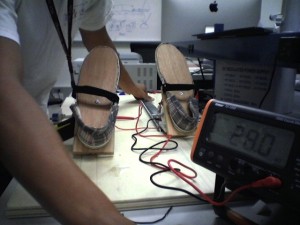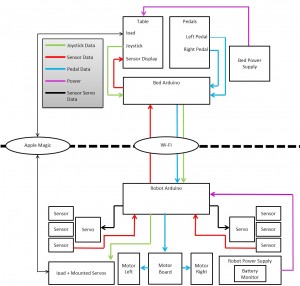Building a Therabot
 Studio Art faculty member Simon Penny and ICS faculty member Judith Gregory are mentoring a team of UCI students who have received funding to build ‘Therabot’, a remote-controllable robot avatar designed for bedridden kids. The team leaders are Emanuel Sakzlyan and Katie Tilford (Studio Art, CTSA), and the team members are Geof Kaiser (Studio Art), Michael Luong (EECS, SoE),Tram Pham (Biomedical Engineering), and Patricia Guan (School of Medicine). They received a UCI UROP/CALIT2 2012 Multidisciplinary Design Project (MDP) award for the Therabot project.
Studio Art faculty member Simon Penny and ICS faculty member Judith Gregory are mentoring a team of UCI students who have received funding to build ‘Therabot’, a remote-controllable robot avatar designed for bedridden kids. The team leaders are Emanuel Sakzlyan and Katie Tilford (Studio Art, CTSA), and the team members are Geof Kaiser (Studio Art), Michael Luong (EECS, SoE),Tram Pham (Biomedical Engineering), and Patricia Guan (School of Medicine). They received a UCI UROP/CALIT2 2012 Multidisciplinary Design Project (MDP) award for the Therabot project.
Therabot is multifunctional embodied avatar by which bedridden kids can do errands, carry on conversations, and even play games, i.e. with other kids via their therabots. Therabot will be controlled from the bed and possess two-way audio and video. The Therabot will offer alternative modes of control that utilize body parts in ways that promote the well-being of patients and prevent the atrophy of muscles. For instance, via a foot-controlled steering interface, the device will provide physical therapy in the form of motor control and muscle exercise for the legs. Therabot will afford bedridden kids virtual mobility, sociality, and gameplay, while providing targeted and customized physical therapy in the hospital environment (and possibly beyond through the use of GPS-enabled robots).
 The project arose out from the personal experience of Emanuel, who was bedridden with leukemia throughout early high school. He had direct experience with the ways that being confined to a bed can take a toll on the body and mind—soreness and difficulty getting out of bed or even standing up, as well as social isolation. This experience can be quite demoralizing. The patient often loses confidence and the will to participate in physical therapy. Our goal is to incorporate play, physical activity and active tele-social interaction into what can be a tedious and difficult road to recovery, and to bolster the patient’s agency in his or her interactions with the world and the healing process itself.
The project arose out from the personal experience of Emanuel, who was bedridden with leukemia throughout early high school. He had direct experience with the ways that being confined to a bed can take a toll on the body and mind—soreness and difficulty getting out of bed or even standing up, as well as social isolation. This experience can be quite demoralizing. The patient often loses confidence and the will to participate in physical therapy. Our goal is to incorporate play, physical activity and active tele-social interaction into what can be a tedious and difficult road to recovery, and to bolster the patient’s agency in his or her interactions with the world and the healing process itself.
It is planned that the project will be prototyped in Spring 2012 and tested at UCI Medical Center in Summer 2012. The project falls into both the health care and culture thrust areas of CALIT2.